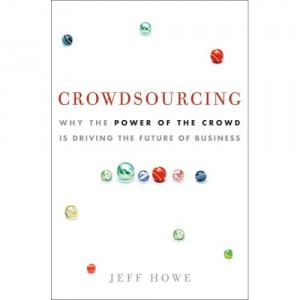The following was written by a reviewer named “M McDonald” in Amazon. I thought he did such a great job of summarizing the book, I couldn’t do a better job than copying it here and giving him the credit:
The book focuses on describing how to crowds are creating new sources of value than the specific ways to tap into that value. Chapters 1 through 5, the first half of the book, concentrates on providing examples of the crowd sourcing phenomenon. The second half focuses down on the impact of crowds to economic and business organization.
Chapter 1: The Rise of the Amateur – discusses the shifting balance between individuals with deep expertise and communities of interest. These differences and the increasing amateur access to information and collaboration are changing the playing field in multiple disciplines for the better.
Chapter 2: From So Simple a Beginning – traces the rise of crowd sourcing back to the open source software movement. Howe details the early history of open source software, an interesting tale, as well as its basic principles of self responsibility, community contribution, and breaking large problems into small units. Howe describes the start of Wikipedia, SETI and the USPTO’s use of open software approaches in the chapter.
Chapter 3: Faster, Cheaper, Smarter, Easier – looks at the results that come from employing diversity and crowds to solve complex problems. Examples here range from desktop publishing, viral video, and music. In each case, the shift from centralized to distributed production results in the transformation of markets and the creation of new opportunities.
Chapter 4: The Rise and Fall of the Firm – puts together the principles of the first three chapters and describes their collective impact on modern business and market structures. Howe uses readily accessible examples, like CincyMoms, to illustrate how open access; amateur interest and aggregating intelligence upset traditional markets and organizations. This chapter is well researched and may be the best of the book as it bridges between academic studies (Benkler’s “The Wealth of Networks’) with real life examples.
Chapter 5: The Most Universal Quality – discusses the role of diversity and the power of crowds to aggregate diversity to match or out perform experts in many different situations. This chapter is the most like the Wisdom of Crowds as Howe explains both socially and mathematically how a crowd of amateurs can be more accurate than an individual expert.
Chapter 6: What the Crowd Knows is an extension of Chapter 5 and concentrates on the channeling of crowd wisdom into collective wisdom through prediction markets and other types of solutions. The chapter also introduces the idea of Marketocracy as a means to find talent in a crowd based on their results rather than their resumes.
Chapter 7: What the Crowd Creates focuses on the creative aspects of communities that require a different set of solutions to the aggregation of collective intelligence. These chapter discuses the notion of user-generated content and its dynamics based on tools, incentives, rewards, and ownership. It dives deep into the operation of iStock as an example of a company that harnesses the creations of a community.
Chapter 8: What the Crowd Thinks recognized the power of personal expression in terms of participatory decision making, reviews and visibility. Howe points out that about 10% of a community provides their opinions and views, setting the tone for the overall community. However those opinions operate as a significant filter for the community. BTW, Howe points out that Amazon reviews are an example of this – so welcome to the crowd. This chapter focuses on phenomenon such as American Idol and Digg as illustrations of crowd opinions.
Chapter 9: What the Crowd Funds is a short chapter that discusses the application of crowd sourcing principles to finance with applications such as peer-to-peer lending, micro-lending and Barak Obama’s appeal to large numbers of small individual donors.
Chapter 10: Tomorrow’s Crowd highlights the rise of the digital native and the fact that people growing up today expect to work more collaboratively than their parents. This chapter explores how this next generation works, multitasks and collaborates. These traits are largely explained through changes in the media industry, which makes sense since digital natives are currently the target audience in that market. It’s just a matter of time before they are the target audience in every market.
Chapter 11: Conclusion – the rules of Crowdsourcing summarizes the book, wrapping its ideas into a few simple and powerful rules:
1. Pick the right model from among collective intelligence, creation, voting, or funding.
2. Pick the right crowd from the participants to the people who will influence and usher the crowd.
3. Offer the right incentives to the crowd that are often expressed in recognition rather just money.
4. Keep the pink slips in the drawer – crowdsourcing is not outsourcing
5. The dumbness of crowds, or the benevolent dictator principle – crowds need leaders who influence
6. Keep it simple, break it down – give the crowd something each individual can work on, yet can aggregate into something great.
7. Remember Sturgeon’s Law – 90% of what is created is crap so you will need to allow the crowd to separate the cream from the crap
8. Remember the 10 percent, the antidote to Sturgeon’s law – related to #7 that the crow can do the sorting in a democratic and open forum better than the experts.
9. The community is always right
10. Ask not what the crowd can do for you, but what you can do for the crowd – a crowd forms and is most effective when it sis working on something it wants.



